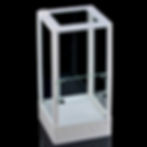Prenolepis imparis, also known as Winter Ants or False Honeypot Ants, is a remarkable species celebrated for its deep underground nests and unique cold-weather foraging habits. These ants, native to North America, build nests as deep as 3.6 meters below the ground surface to maintain themselves in the coolest chambers during the year's warmest months.
They actively forage during colder periods, sometimes even below freezing, avoiding competition with other ant species that cannot tolerate such low temperatures. Another distinguishing feature of this species is the presence of repletes, workers who store fat reserves in their distended gasters.
Not only does Prenolepis imparis display remarkable adaptability in various environments, but the species is also known for its polygynous colonies with relatively small worker populations. Winter Ants are timid, avoiding direct sunlight and being most active in the shade or on cool, cloudy days.
Their diet consists of liquids, including honeydew from aphids and coccids, nectar from flowers and extrafloral nectaries, exudates from living oak galls, juices from dead earthworms, and young plant tissues. They are opportunistic omnivores, feeding on various liquid and semi-liquid food sources.
Prenolepis imparis are very calm ants, ideal for beginners who prefer a species that does not require constant attention. Their serene nature means they do not get easily stressed, making them less prone to defensive behaviors.
These ants exhibit long periods of inactivity during several times of the year, living off the food stored in the gasters of their repletes. This unique behavior allows them to thrive without constant foraging, making them a low-maintenance option.
Female and male alates fly around mid-January to March, with the largest flights in early February. The worker count of multi-queen colonies can reach up to 10,000 ants over 7-9 years, providing a long-term opportunity to observe and study the colony’s growth and development.
This species thrives in groups with multiple queens, so it is recommended that several be placed together in the same test tube. If you order more than one QUEEN ONLY in the same order, we will group them for you; once workers are present, each colony ships independently.
Every queen (or starter colony) ships in a pre-assembled test-tube setup. Components are listed in the “Included Queen Test Tube Setup” info section. For the full breakdown of all options and why we use them, see "Test Tube Components Explained".
Note: Live ants ONLY SHIP within CANADA.
Prenolepis Imparis (Winter Ant)
Scientific Name: Prenolepis imparis
Common Name: Winter ant, about its foraging at temperatures barely above freezing during the cooler months. False Honey Ant is an unfortunate name since the storage product in the corpulent young workers of these ants is fatty, not sugary.
Distribution: Most of the United States, plus southern Ontario and Mexico.
Queen size: 8 mm
Male size: 3-4 mm
Worker size: 2.5-3.5 mm
Natural Habitat: Nest entrances are commonly found in shaded areas near the bases of trees and are characterized by having a series of short dead-end tunnels nearby, presumably for foragers to take temporary shelter from predators or the elements during cold weather. Nests in Florida have been recorded extending as far down as 3.6 meters. From the entrance, the main shaft of the nest extends vertically downward, with no chambers found shallower than 60.0 cm, after which point chambers are very common and are all directly connected to the main shaft.
Circadian Activity: Diurnal
Mating Flight: Late winter/early spring. The winged sexes that participate in the nuptial flights mature during the late summer of the previous year and are retained in the nests over winter. This retention of the sexual phases over winter occurs in a few of our other northern ants. The very early flight of P. impairs first observed at the beginning of spring, February for Florida, followed as states warm to 70 degrees. The queens fly in the afternoon.
Queen Founding Method: Fully claustral
Monogyne or Polygyne: Both. They can be either Monogyne or Polygyne.
Average time from egg to worker: Slow species usually take about two months from egg to adult. Sometimes even 3[/size][/color]
Recommended Temperature: 65-75 F.
Recommended Humidity Prefers deep chambers closer to moist clays and soils.
Preferred Foods: Workers feed on honeydew, secretions of floral, sap flow, exudates from galls, earthworms and arthropods (usually as carrion), and ripened or decaying fruit.
Hibernation Details: P. imparis do not hibernate but have a distinct estivation period. As an apparent adaptation for this estivation, most workers (average 78%) were in the "replete" state. During estivation, eggs are laid and reared, and new workers emerge in "winter." In north Florida, the ant is absent above ground for 7 to 8 months, foraging only during the winter.
Escape Barrier Methods: Talcum powder or Fluon
Difficulty rating: Starting an ant colony with P. imparis is pretty simple. It would be best if you had a suitable starting habitat, and placing at least two queens together is recommended to increase the chances of them founding a solid colony. The mortality rate for newly mated queens is high (estimated in the wild as high as 95%/100%), You can feed the queens a little sweet liquid at first, but then they will not need feeding until after the first workers arrive in a couple of months. It is essential to know that subsequent generations of workers will not take as long as the first to go from egg to worker. P. imparis queens are easily disturbed like most queens. When disturbed during the founding stage, they will quickly abandon their eggs. This means keeping them shielded from vibrations, light, and airflow is very important. If you are used to keeping some queens where you can leave them out in the open without worry, they are not as suited for that type of environment.
Bite and Sting rating: No sting or bite.
Special Care or Interesting Notes: The two sexes differed in colour. Hence he named the species imparis.Information source: https://www.formiculture.com/
















